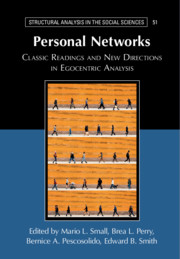Book contents
- Personal Networks
- Structural Analysis in the Social Sciences
- Personal Networks
- Copyright page
- Contents
- Figures
- Tables
- Contributors
- I Background
- II Early Foundations
- 1 From Georg Simmel, “On the Significance of Numbers for Social Life: Introduction,” “The Isolated Individual and the Dyad,” “The Triad,” and “The Web of Group Affiliations”
- Georg Simmel’s Contribution to Social Network Research
- 2 From Elihu Katz and Paul F. Lazarsfeld, Personal Influence
- Influencers, Backfire Effects, and the Power of the Periphery
- 3 From J. Clyde Mitchell, “The Concept and Use of Social Networks”
- On J. Clyde Mitchell’s “The Concept and Use of Social Networks”
- 4 From Elizabeth Bott, “Urban Families: Conjugal Roles and Social Networks”
- Commentary on Bott’s “Family and Social Network”
- 5 From Leon Festinger, Stanley Schachter, and Kurt Back, Social Pressures in Informal Groups
- Festinger, Schachter, and Back’s Social Pressures in Informal Groups
- 6 From H. Russell Bernard, Peter Killworth, David Kronenfeld, and Lee Sailer, “The Problem of Informant Accuracy”
- Implications of Informant Accuracy Research for Ego Networks
- 7 From Harrison C. White, Identity and Control
- On Parachutes and Lion-Taming
- III Later Foundations
- IV New Perspectives
- Index
- Recent Books in the Series
- References
Implications of Informant Accuracy Research for Ego Networks
from II - Early Foundations
Published online by Cambridge University Press: 01 October 2021
- Personal Networks
- Structural Analysis in the Social Sciences
- Personal Networks
- Copyright page
- Contents
- Figures
- Tables
- Contributors
- I Background
- II Early Foundations
- 1 From Georg Simmel, “On the Significance of Numbers for Social Life: Introduction,” “The Isolated Individual and the Dyad,” “The Triad,” and “The Web of Group Affiliations”
- Georg Simmel’s Contribution to Social Network Research
- 2 From Elihu Katz and Paul F. Lazarsfeld, Personal Influence
- Influencers, Backfire Effects, and the Power of the Periphery
- 3 From J. Clyde Mitchell, “The Concept and Use of Social Networks”
- On J. Clyde Mitchell’s “The Concept and Use of Social Networks”
- 4 From Elizabeth Bott, “Urban Families: Conjugal Roles and Social Networks”
- Commentary on Bott’s “Family and Social Network”
- 5 From Leon Festinger, Stanley Schachter, and Kurt Back, Social Pressures in Informal Groups
- Festinger, Schachter, and Back’s Social Pressures in Informal Groups
- 6 From H. Russell Bernard, Peter Killworth, David Kronenfeld, and Lee Sailer, “The Problem of Informant Accuracy”
- Implications of Informant Accuracy Research for Ego Networks
- 7 From Harrison C. White, Identity and Control
- On Parachutes and Lion-Taming
- III Later Foundations
- IV New Perspectives
- Index
- Recent Books in the Series
- References
Summary
There were six informant accuracy articles published by Bernard, Killworth, and their colleagues between 1976 and 1982 reporting on seven data sets. The first five articles limited the scope of the results to social network data.
- Type
- Chapter
- Information
- Personal NetworksClassic Readings and New Directions in Egocentric Analysis, pp. 174 - 184Publisher: Cambridge University PressPrint publication year: 2021



